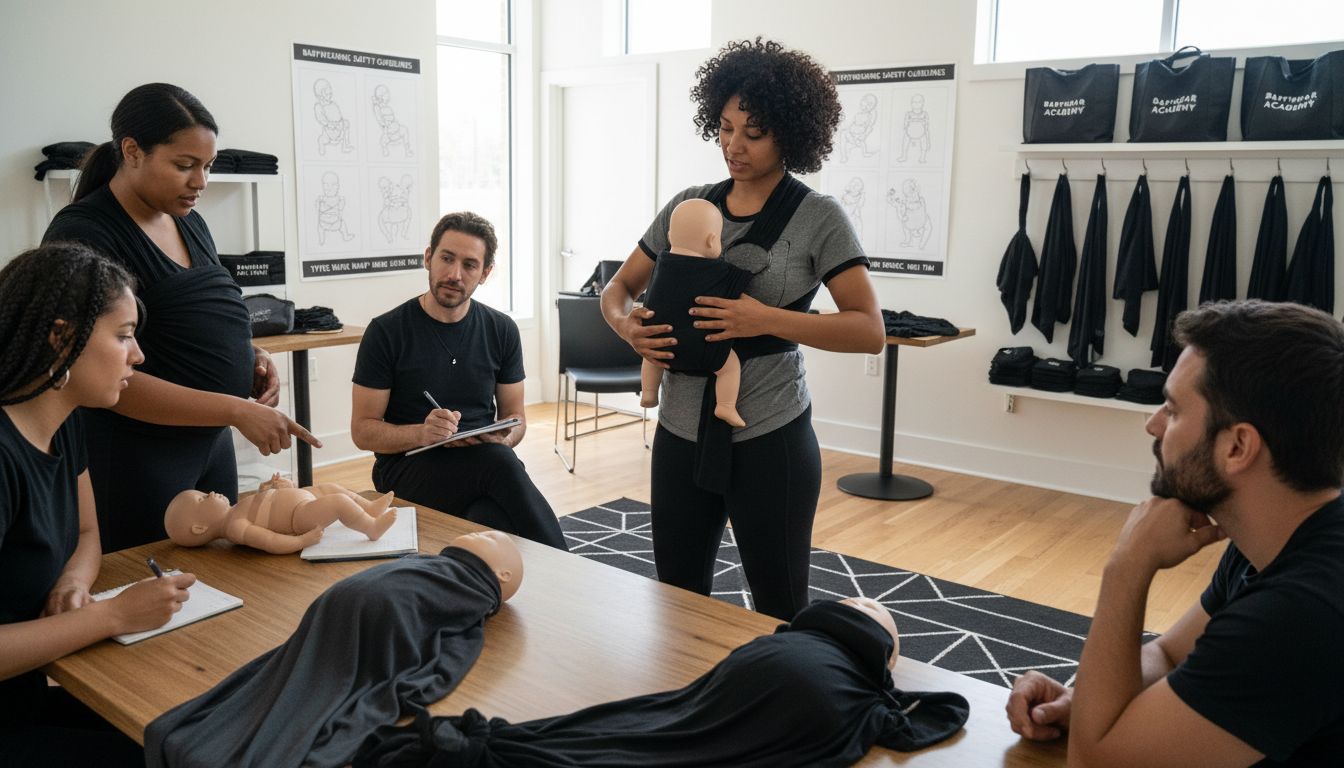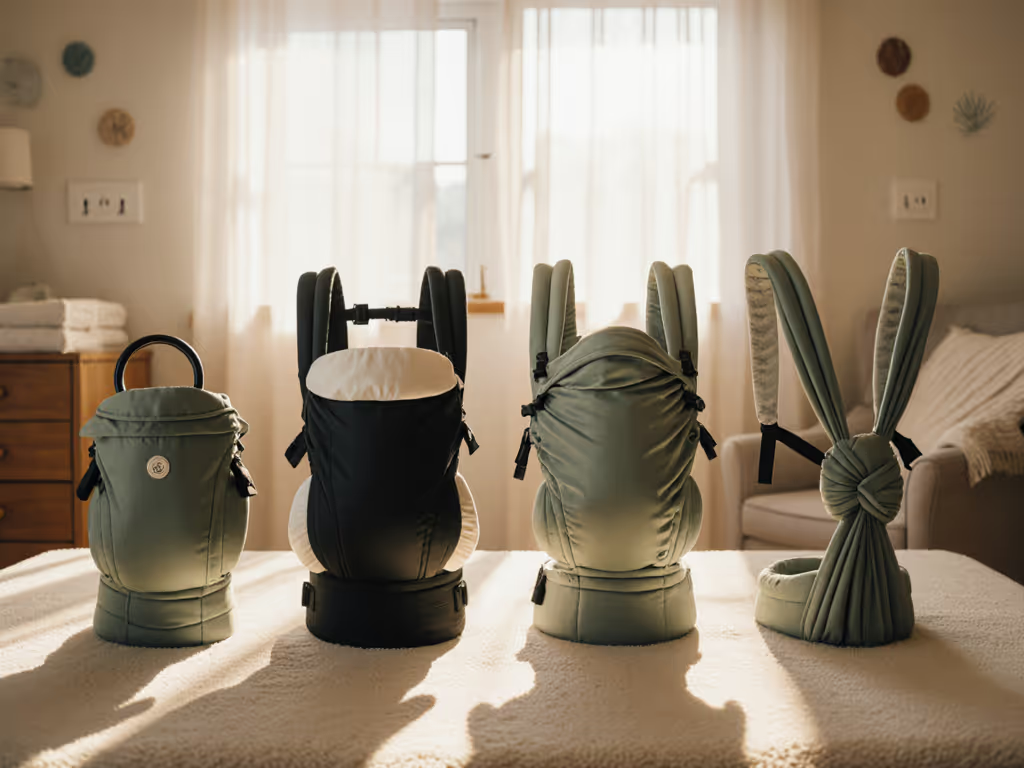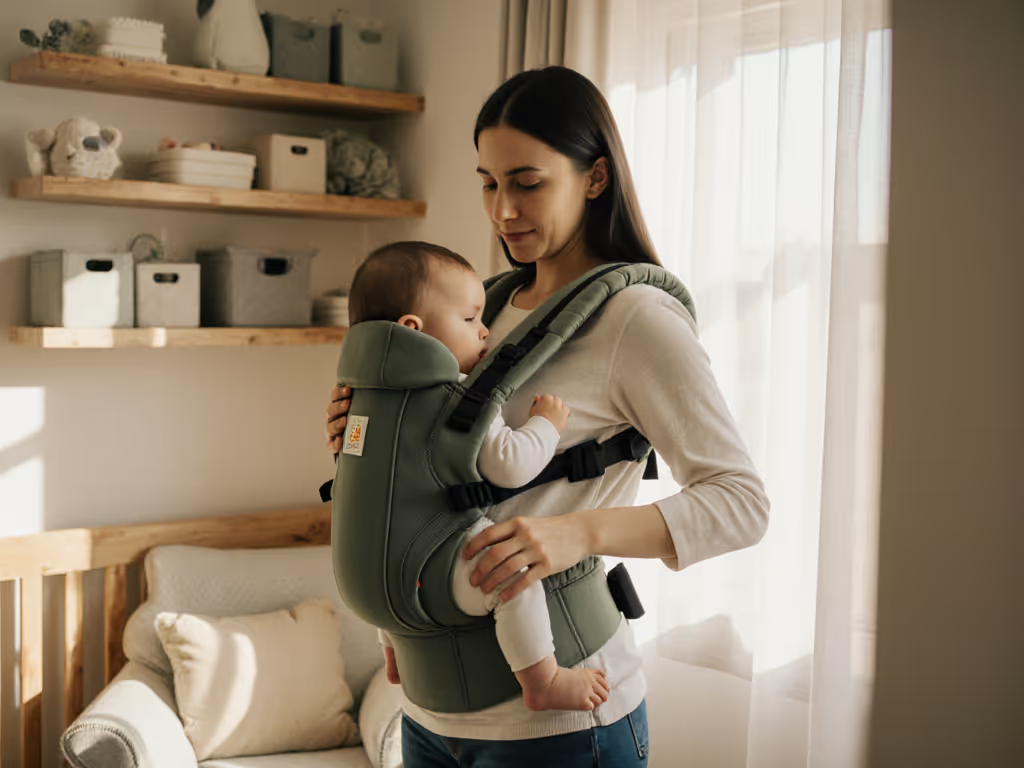
Why Slings for Newborns: Complete Caregiver Guide

Did you know that babies carried in slings cry nearly 50 percent less than those who are not? For new parents, finding comfort while keeping their newborns close can feel overwhelming. A well-chosen sling supports your baby's development, keeps your hands free, and builds emotional connection from day one. Understanding the right way to use a sling will help your newborn feel safe and supported throughout those early months.
Key Takeaways
| Point | Details |
|---|---|
| Versatile Benefits of Baby Slings | Slings support skin-to-skin contact, healthy hip positioning, and offer emotional bonding opportunities while allowing hands-free movement for caregivers. |
| Safety and Proper Positioning | Always ensure positioned for clear airways, visibility, and ergonomic support to avoid risks associated with babywearing. |
| Types of Slings | Understanding the diverse slings (e.g., ring, wrap, pouch) assists in selecting the right carrier based on adjustability and specific needs for the infant. |
| Comparison with Other Carriers | Slings provide a more intimate and flexible alternative to structured carriers, enhancing sensory interaction and supporting infant development. |
Understanding Slings for Newborns
Babywearing is more than just a parenting trend - it's a centuries-old practice that creates profound connections between caregivers and newborns. Baby slings represent a versatile and intimate method of carrying your infant, offering both practical support and emotional bonding opportunities. Unlike traditional carriers, slings wrap closely around your body, creating a secure and comfortable environment that mimics the warmth and safety of the womb.
At its core, a baby sling functions as a flexible fabric designed to hold your newborn close to your body. The primary purposes extend far beyond simple transportation. These ingenious tools provide critical benefits for infant development and caregiver comfort. Key advantages include:
- Promoting skin-to-skin contact which regulates infant body temperature
- Supporting natural hip positioning for healthy developmental growth
- Reducing infant stress through consistent physical proximity
- Enabling hands-free movement for caregivers
- Facilitating easier breastfeeding in public settings
Choosing the right sling requires careful consideration of multiple factors. Newborns have delicate skeletal structures and limited neck muscle control, making proper support absolutely essential. The National Childbirth Trust recommends selecting carriers that provide adequate head and neck support while maintaining a natural, ergonomic position. This means looking for designs that keep your baby's spine aligned in a gentle, slightly curved "M" shape - with knees higher than their bottom and legs spread apart.
While slings offer tremendous benefits, safety remains paramount. Always ensure your newborn can breathe easily, maintain a clear airway, and remain visible. Position matters significantly - your baby should be high enough on your chest that you can kiss the top of their head, and the fabric should support their entire back without folding them into a tight, compressed position. With proper selection and usage, a sling transforms from a simple piece of fabric into a powerful tool for nurturing your newborn's physical and emotional development.
Major Types of Newborn Slings
Navigating the world of newborn slings can feel overwhelming, but understanding the different types will help you choose the perfect carrier for your little one. Sling varieties have evolved from traditional cultural practices into sophisticated carrying solutions, each designed to meet specific parenting needs and infant comfort requirements.
Three primary categories of slings dominate the babywearing landscape:
Here's a comparison of the main types of newborn slings:
| Sling Type | Adjustability | Key Benefits | Ideal For |
|---|---|---|---|
| Ring Sling | High<br>Quick changes | Easy breastfeeding<br>Breathable<br>Multiple holds | Everyday use<br>Newborns |
| Wrap Sling | Very high<br>Custom fit | Even weight distribution<br>Secure fit<br>Supports growth | Beginners (stretchy wrap)<br>Older babies (woven wrap) |
| Pouch Sling | Low<br>No adjustment | Fast to put on<br>Simple design | Quick errands<br>Experienced users |
 |
|
- Ring Slings: Versatile and adjustable fabric carriers with two rings for quick positioning
- Wrap Slings: Long, continuous pieces of fabric that wrap intricately around the caregiver's body
- Pouch Slings: Simple, non-adjustable fabric tubes designed for quick, simple carrying
The ring sling represents perhaps the most adaptable option for newborn carrying. Constructed from a long piece of fabric threaded through two rings, these slings allow rapid adjustment and multiple carrying positions. They excel in providing quick access for breastfeeding and offer excellent breathability. Most ring slings measure approximately 2-2.5 meters long, providing ample fabric for creating secure, comfortable holds for infants weighing between 7-15 pounds.
Wrap slings offer the most customizable fit, essentially functioning as a second skin for both caregiver and infant. These fabric carriers distribute weight more evenly across the wearer's body, reducing strain and providing exceptional support. Stretchy wraps work best for newborns, offering gentle compression and mimicking the tight, secure feeling of the womb. Woven wraps, in contrast, provide more structure and can support older infants and toddlers. Professional babywearing consultants often recommend mastering wrap techniques through hands-on practice or instructional videos to ensure safe and comfortable usage.

Benefits for Infant Development and Bonding
Babywearing isn't just a convenient method of carrying your newborn - it's a powerful developmental tool that supports crucial physical, emotional, and cognitive growth. Infant bonding through close physical contact creates a neurological foundation that influences a child's future social and emotional intelligence. By keeping your baby close, you're doing much more than transportation - you're actively participating in their earliest learning experiences.
The physiological benefits of sling carrying are profound and scientifically documented. Newborns experience significant advantages through consistent physical proximity, including:
- Regulated heart rate and breathing patterns
- Enhanced neurological development through sensory stimulation
- Improved vestibular system functioning
- Decreased stress hormone production
- More consistent sleep cycles
Research from the National Childbirth Trust highlights how babywearing directly impacts infant emotional security. When newborns are carried close to a caregiver's body, they experience a continuous sensory dialogue - feeling heartbeats, experiencing body movements, and hearing conversational sounds. This constant interaction helps babies develop a sense of secure attachment, which becomes the cornerstone of their future emotional resilience and interpersonal relationships.
Beyond emotional benefits, sling carrying supports critical physical development milestones. The natural positioning in a sling - with legs spread and spine gently curved - promotes healthy hip joint formation and muscle development. Babies carried in slings tend to have stronger neck muscles and better head control, as they're constantly adjusting to subtle movements and learning to stabilize themselves.
This active engagement contrasts sharply with stationary positioning in cribs or car seats, offering a dynamic environment that encourages early motor skill development and spatial awareness.
Essential Safety and Proper Positioning
Babywearing safety isn't just a recommendation - it's a critical responsibility that requires constant vigilance and informed practice. Infant positioning represents the most crucial element of safe sling use, directly impacting your newborn's respiratory and physical well-being. Understanding and implementing proper techniques can transform a potentially risky situation into a secure, nurturing experience.
Premier Health emphasizes several non-negotiable safety guidelines for sling use:
- Maintain a clear airway at all times
- Ensure baby's chin is not pressed against their chest
- Keep baby's face visible and uncovered
- Position baby high enough to kiss the top of their head
- Regularly check infant's breathing and comfort
The most dangerous risk in sling carrying is accidental suffocation, which can occur when an infant's delicate airway becomes compressed or obstructed. Medical experts recommend the "TICKS" rule for safe babywearing: Tight carriers, In view at all times, Close enough to kiss, Keep chin off chest, Supported back. This means your sling should be snug but not restrictive, allow you to see your baby's face, position them high enough for easy monitoring, prevent chin-to-chest positioning that can restrict breathing, and support their entire spinal column.
Proper positioning involves more than just preventing breathing risks. Ergonomic placement supports your newborn's developing muscular and skeletal system. The ideal sling position mimics the natural "M" shape - with baby's knees higher than their bottom, creating a spread-squat position that promotes healthy hip development. This positioning reduces stress on developing joints and supports natural spine curvature. Always ensure the fabric supports the entire back, distributes weight evenly, and allows natural movement without creating unnecessary tension or strain on your infant's developing body.
Comparing Slings to Other Baby Carriers
Every baby carrying method offers unique advantages, but slings stand out as the most intimate and adaptable option. Unlike structured carriers that can feel rigid and impersonal, slings create a seamless connection between caregiver and infant, transforming transportation into a profound bonding experience. Understanding the nuanced differences between carrying methods helps parents make informed choices that align with their lifestyle and infant's developmental needs.
Key comparisons between sling and alternative carrier types reveal distinct characteristics:
- Slings: Flexible fabric, most adaptable positioning
- Structured Carriers: Rigid design, preset carrying positions
- Wrap Carriers: Long fabric, complex wrapping techniques
- Backpack Carriers: Rear-facing, limited for newborns
- Mei Tai Carriers: Hybrid between structured and wrap styles
Structured carriers, typically featuring buckles and padded straps, provide more predetermined positioning compared to slings. While they offer excellent support for older infants, they lack the nuanced adaptability crucial for newborn carrying. These carriers often require specific weight ranges and may not accommodate the delicate positioning needed for infants under three months. Slings, in contrast, can be immediately adjusted to support a newborn's unique physical requirements, creating a custom-fit environment that mimics the womb's protective embrace.
Backpack and structured carriers excel in specific scenarios - like hiking or extended outdoor activities - but fall short in providing the continuous sensory interaction essential for infant development. Slings create a living, breathing ecosystem of communication, allowing babies to experience their caregiver's movements, hear heartbeats, and engage with environmental stimuli. This constant interaction supports neurological development in ways that more rigid carrying methods cannot replicate. The fabric's responsiveness allows for immediate temperature regulation, subtle movement adaptation, and uninterrupted physical connection that structured carriers simply cannot match.
Discover the Best Sling Solutions for Your Newborn's Safety and Comfort
Choosing the right sling for your newborn can feel overwhelming with so many options and safety concerns to consider. This article highlights key challenges such as ensuring proper neck and hip support, maintaining clear airways, and achieving the perfect ergonomic "M" position that promotes healthy development. You want to feel confident carrying your baby close while knowing you are supporting their emotional and physical well-being securely.
At Caregiver Carry, we understand these concerns deeply. Our platform offers expert-backed guides and detailed safety checklists that help you select a sling that fits your lifestyle and your baby's unique needs. Explore our comprehensive buying guides where you can compare ring slings, wrap slings, and pouch slings tailored to newborns. Do not wait to give your baby the secure, loving connection they deserve. Visit Caregiver Carry now to find sling options and advice that will empower you to wear your baby safely and comfortably every day.
Frequently Asked Questions
What are the benefits of using a baby sling for my newborn?
Baby slings promote skin-to-skin contact, support natural hip positioning, reduce infant stress, enable hands-free movement, and facilitate easier breastfeeding.
How do I choose the right sling for my newborn?
Look for slings that provide proper head and neck support, ensure a natural ergonomic position, and maintain gentle spinal alignment, mimicking the 'M' shape for safe development.
What safety measures should I take when using a baby sling?
Maintain a clear airway, ensure the baby's chin is off their chest, keep their face visible, position the baby high enough to kiss their head, and regularly check their comfort and breathing.
How do slings compare to other types of baby carriers?
Slings offer flexible fabric that allows for adaptable positioning, in contrast to structured carriers which are rigid, preset, and may lack the intimate connection essential for newborn development.



